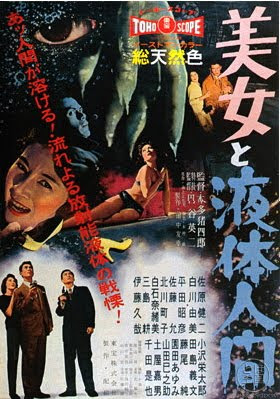
I’m not sure why it took me so long to get to the second feature in the Toho Collection set, but here we are. This particular feature is an interesting change of pace, as we go from kaiju-scale to street level; THE H-MAN, known in Japan by the rather lyrical title BEAUTY AND THE LIQUID PEOPLE, is a blend of sci-fi thriller and crime drama with a touch of romantic nightlife thrown in, as well as some more-pointed-than-usual anti-nuke commentary. It’s the sort of weird film I’d hear about long before ever having the opportunity to actually see it, and it’s a hard one to pin down afterwards; a fun little obscurity which serves as a nice counterpoint to THE BLOB from the same year.
The story begins with the strange disappearance of a mobster who is hit by a car, in an accident which leaves his clothes but no body. The cops are baffled, and start tailing his main squeeze, a nightclub singer named Chikako (Yumi Shirakawa). Chikako, it seems, has also been in touch with a scientist named Masada (Kenji Sahara), who is also interested in her boyfriend’s case; he’s been working on a theory that a person could actually dissolve from exposure to radiation. Sure, our missing gangster Misaki hasn’t been to Bikini Atoll recently, but Masada has heard of a group of sailors who found a seemingly abandoned ship that had been bathed in fallout from a nuclear test; the ship’s crew melted and turned into a living slime creature, and some of the sailors from the smaller vessel are dissolved and absorbed before the survivors escaped. He thinks that the ship may have drifted to Tokyo (perhaps guided by the victims’ memories), and that the entity- an “H-Man”, born from the H-bomb- is now at large in the city.
The police, needless to say, are skeptical. At least, until the H-Man- which appears sometimes as a moving puddle of green ooze, sometimes in a slimy humanoid shape, and sometimes as several human forms- attacks the nightclub where Chikako works, eating a few people before sliding out the window. Misaki is obviously part of the collective now, and the strangest manhunt in history begins, complicated by there still being some angry gangsters at large.
THE H-MAN benefits from a really strong premise, one I could imagine being translated to a modern horror film without much trouble. There’s something fundamentally horrible about the idea; the monster isn’t just a blob that attacks people, but the victims of fallout merged into a horrific faceless gestalt that grows with each person it absorbs. Inoshiro Honda gives us some really striking images here, particularly an eerie shot of the slime beings standing on the deck of the ruined craft like ghosts. The dissolving effects are also unsettlingly convincing, bordering on quite gory for late-Fifties Japan. And of course, we can’t overlook the nuclear angle being stronger than ever; the deaths of the crew on the fishing boat are, as in GOJIRA, a parallel to the Lucky Dragon incident where several Japanese sailors were exposed to fallout and suffered horrific lingering deaths as a result. Of the various Toho sci-fi and fantasy films from this era that I’ve seen, this is the closest to pure horror, and it creates a strong atmosphere from the start.
Of course, this is all blended with good old fashioned cops and robbers business, and it’s an odd mix. We get a few nightclub cabaret scenes featuring Chikako (who sings in English but is still subtitled) and some lovely dancing girls, and the jazzy score is by Masuro Sato (who also composed the weirdly Sousa-esque theme that plays under the opening credits.) At times the two major plots don’t mesh that well; it’s hard to keep track of the various principals involved in the mob business, especially as it becomes increasingly irrelevant in the face of a killer slime rampage. It’s diverting enough, and does add some interesting wrinkles to the plot.
Though not Honda and Toho’s best from this period- apart from the plot sometimes being messy, the climax drags on a bit- THE H-MAN is a surprisingly effective chiller, which retains a lot of its original creepiness. Dark and colorful and quirky, it’s another grand oddity from a studio that was getting really good at such things.
Story by Hideo Unagami
Screenplay by Takeshi Kimura
Directed by Inoshiro Honda
Grade: B+
No comments:
Post a Comment